By: Sara Laitinen, Minna Leppänen and Anniina Mutanen
Pictures: Hillamaria Pirhonen
Introduction
Over the recent decades English has become a global language par excellence, and it is used, for example, in the fields of science, business and travel all around the world. According to Crystal (2003: 3-5), a language becomes global when it achieves a certain position that is acknowledged in all countries, and also when it is taught in places where it is not the official language. English has attained these criteria, and thus it is often used as a lingua franca in multicultural settings. Therefore, English as a lingua franca (ELF) is a “contact-language” between people from different linguistic backgrounds (Firth 1996:240).
Researchers have found some common features in the way English is spoken in an ELF setting. For example, Seidlhofer (2001) found that even though ELF speakers often forget to use the third person singular present tense ‘-s’ marking in their verbs, it does not usually lead to misunderstandings or communication problems. Furthermore, Jenkins (2000) found that although a portion of non-native English speakers are not able to correctly pronounce some sounds that are regarded as “particularly English” (for example the th sounds /θ/ and /ð/) , it does not decrease their intelligibility when speaking English. These studies indicate that “correctness” is not a major concern among ELF speakers, but the focus is in conveying the intended message.
Data and methods
The aim of our project was to find out how English is used in a multilingual setting. We wanted to base our study upon authentic material. Therefore, we decided to make our own observations in a unique interactional setting. We collected our data by observing a one-hour training session of a Gaelic football team and by interviewing the team’s coach, Shane McDermott. The team under observation, Jyväskylä GAA, is a Gaelic football team founded in 2014. It is one of the three Gaelic football teams in Finland; the other two are based in Helsinki and Oulu. The Jyväskylä team has thirty members who speak roughly twelve different native languages. The large variety of first languages was the main reason for our choice of topic along with the interesting context. Gaelic football is an originally Irish team sport that combines throwing, kicking and soloing the ball within a team. Points are scored either by kicking or hand-passing the ball over the crossbar, which all lead to one point or kicking it into the goal, which is worth three points.
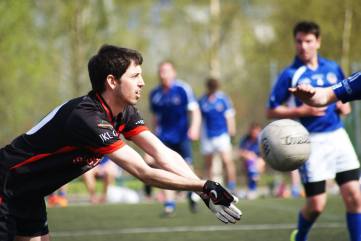
In order to get a proper idea of the purposes of English use within the team, we observed one training session of the Jyväskylä GAA. During the session, we counted the different languages used and wrote down our observations regarding English use. Unfortunately, we were not able to recognize and analyze all the languages spoken, but only the ones that we speak or understand ourselves. That is why our clear focus was on English phrases and in what kind of situations they were used. However, we were able to figure out at least some of the phrases and words or at least their purpose, for example cheering. The mixing of languages and code-switching was also looked at more closely. In addition, we looked at the body language and gestures as well as how they supported the communication in the team. We were also interested to find out if there were any misunderstandings, and if so, how they were corrected. In addition to our own observations, we got a few spontaneous comments from the players on how the different languages affect the team. After gathering our observations, we analyzed the findings in order to get answers to our research questions. The interview of the coach Shane McDermott was made after the training session. The aim of the interview was to give us more insight to our topic from the coach’s point of view since he is talking the most at trainings.
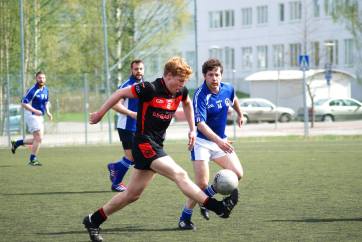
Observations
We observed one training session of the Jyväskylä GAA team in order to understand how English is used in this multilingual environment. The session lasted for an hour, which gave us a relatively good idea of the team’s language use. There were 16 participants, 9 men and 7 women, in the session. They practiced all kinds of drills related to the sport, such as kicking, throwing and picking up the ball in pairs and in larger groups. We made our own observations, wrote field notes on their language use and paid attention to what kinds of means were used when interacting with the other people in the field. The main communicational means that we noticed during this training session were different languages and gestures, which are now discussed in detail.
English was clearly the lingua franca of the session. It was used between the coach and the players, and also between players with different nationalities. Other languages that we heard were, for example, Italian, Spanish, Finnish, Polish and Gaelic. These languages were used in the form of single words or phrases in short utterances when said aloud to the whole team, but when they were used between two speakers of the same language the utterances became increasingly complicated. The English used during the session was explicit and understandable; the structures were simple and the vocabulary was not complex. Important issues were emphasized with stress or repetition, such as in the command “Pick up the balls”, which was repeated most likely to prevent any problems with either hearing or understanding the message.
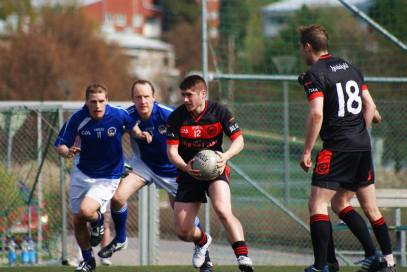
The most remarkable discovery we made in our observations was that code-switching happened very often in the training session. As mentioned above, we heard several different languages being spoken, mostly by two native speakers of that particular language. During competitive situations many different languages were also shouted back and forth among the whole group. Hence code-switching was used, firstly, to discuss or clarify issues with your countryman and, secondly, to create humour or encourage others during the drills. For instance, one cheer “Juokse (name) juokse” was used by a non-Finnish speaker, which indicated that this person (and others) knew the meaning of the cheer and used it to encourage others and to create humour. Overall, code-switching helped the members to be a part of the group, to use inside jokes and to clarify how certain drills should be done.
In addition to different languages, gestures had an important role in the interaction. The coach, for example, used different gestures when he demonstrated the drills physically. The gestures were therefore used to give examples and orders, to clarify what was said verbally, and to verify what was heard. The members used also many different kinds of gestures, such as pointing, when communicating with each other during and between the drills. This may, however, be a universal feature of all kinds of team sports; with gestures one can easily and effectively get the attention of the hearer and emphasize what was said. Hence it is obvious that they were also used in the training session that we observed.

This very multilingual and interactional training session showed how English was clearly used as a lingua franca in the Jyväskylä GAA team. It was a communicative tool that enabled the training session to be successful, since it was the only language that all the members of the team understood. Our observations also showed how different languages, code-switching and gestures had an important role in creating the interaction between the team members. These communicational means were used excessively in the training session, which proves their importance in how meanings are constructed in multilingual environments.
Interview
The aim of the interview with coach Shane McDermott was to learn more about the way in which English is being used as a lingua franca in the team. We were especially interested in three questions: Firstly, what kinds of problems occur when using ELF in an extremely multilingual environment? Secondly, how does the coach overcome these problems? And finally, how are the Finnish language and culture represented in the team?
According to McDermott, the biggest challenge for him as the coach of the team is that he cannot always be sure if everyone understood what he aims to communicate, especially during matches. McDermott speculates that the problems might be due to the fact that the people in the team are not used to hearing and using very different accents and varieties of English. For example, McDermott himself is from the midlands of Ireland, where the accent differs quite a bit from the standard British and American English varieties most people in the team have learned in school. Furthermore, the lexicon and even the syntax in Irish English occasionally differ from the standard varieties, which can cause problems in understanding, even when the other speaker is fluent in English.
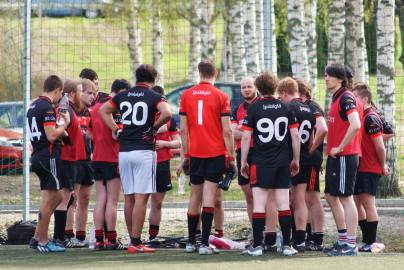
In order to avoid misunderstandings, McDermott tries to use common words and simple sentence structures when talking to the team at trainings. Additionally, he always tries to physically demonstrate the drills to further clarify what he means. Furthermore, the players in the team use code-switching to explain the drills to each other if someone didn’t understand. McDermott emphasizes that even though the fact that the players don’t share the same first language can cause some communicational problems, it also has its benefits: All of the players bring something positive from their own cultures to the team. In addition, code-switching and mixing all the different languages known by the team members create humor and inside jokes, which is important for the group’s unity and team spirit.
McDermott mentions that a lot of the players join the team specifically to speak English and learn more about the Irish culture. However, the Finnish culture is also present at the team’s activities. As an example McDermott mentions the team’s sauna nights and celebrating Finnish holidays. Even though most players on the team speak, or have studied some Finnish, it isn’t used at the training sessions. McDermott reveals, however, that Finnish is sometimes spoken, for example, at the team’s sauna nights when all the people present at that time can speak, or want to practice their Finnish. As a conclusion McDermott says that code-switching in general is very common on the team and that all languages are useful if they help people to get their point across.
Conclusion
English is often used as a lingua franca between non-native speakers in all kinds of situations around the world (Firth 1996: 237). This project showed that the members of Jyväskylä GAA team use English as a lingua franca as well when they communicate with each other during training sessions, matches and other activities. The team’s interaction is constructed through several different communicational means, which make the interaction possible and successful. The main means that we noticed were different languages, gestures and code-switching. Other languages besides English are used mostly in short sentences and utterances or conversations between two native speakers. Gestures and body language provide help and examples in drills during practice.
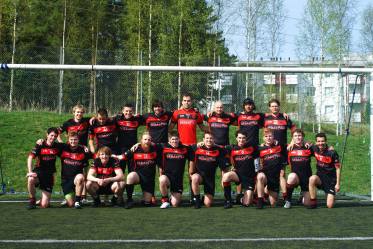
Our observations and interview combined revealed that code-switching always has a function, whether it is creating humor, building connections or making yourself understood. Perhaps the most significant finding of this project is that in a multilingual context, such as Jyväskylä GAA, English is used as a common tool to achieve a communicational goal. This means that it doesn’t matter what variety of English you use, what your accent is like or how much code-switching is needed, just as long as you can get yourself understood.
Bibliography
Crystal, D. (2003). English as a global language. Second edition. Cambridge: Cambridge University Press.
Firth, A. (1996). The discursive accomplishment of normality. On “lingua franca” English and conversation analysis. Journal of Pragmatics 26: 237–59.
Jenkins, J. (2000). The Phonology of English as an International Language. Oxford: Oxford University Press
Seidlhofer, B. (2001). Closing a conceptual gap: the case for a description of English as a lingua franca. International Journal of Applied Linguistics 11: 133–58.

Pingback: The Lingua Franca of Sport | English in Finland 2016